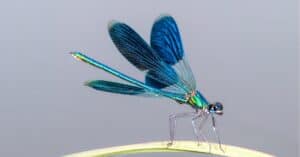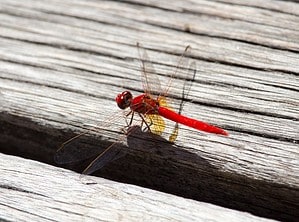Before we discover where dragonflies go in the winter, let’s explore where they stay during the warmer months! Adult dragonflies live near freshwater streams, canals, lakes, riverbanks, ditches, and ponds. Their larvae rest among the rocks and vegetation of streams, lakes, and ponds. These colorful insects are found in every continent across the world — from North America and Europe to Australia and Africa — besides Antarctica. Let’s learn more about the life cycle of the delicate dragonfly.
The Life Cycle of a Dragonfly
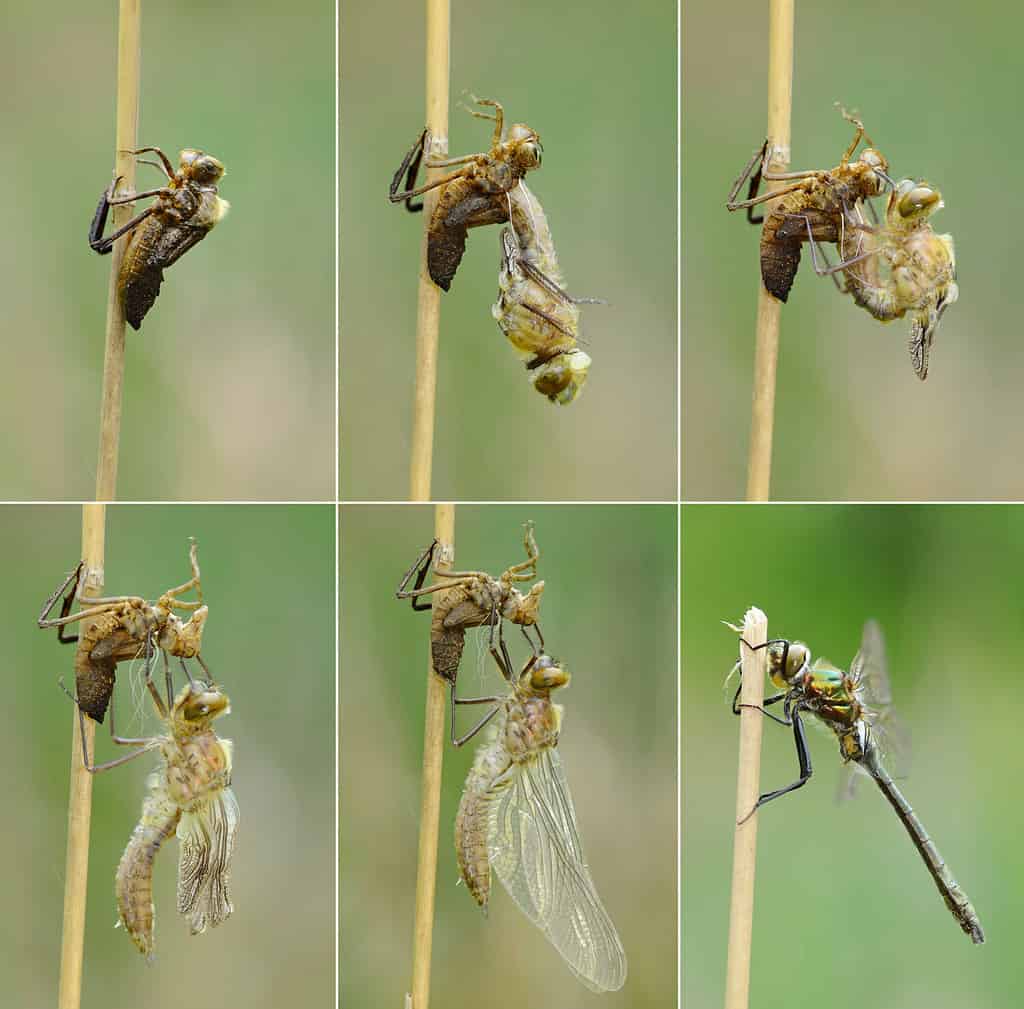
A dragonfly emerges for its first flight as an adult after molting.
©Michal Hykel/Shutterstock.com
There are three stages in the dragonfly life cycle: egg, larva (AKA nymph), and adult.
1. Egg
Every dragonfly egg starts its life near the water. Either in plant material close to the surface like an endophytic egg or under the water like an exophytic egg. Female dragonflies can lay hundreds of eggs in their lifetime, typically in batches over a few days.
In 2-5 weeks, eggs will hatch. However, some species of dragonflies don’t hatch until after winter is over. For example, the emerald damselfly doesn’t emerge until the following spring.
2. Larva (AKA Nymph)
Once the eggs hatch, the larva stays in the water for about 1-2 years. As it develops and grows, it preys on underwater insects to survive. Its diet consists of water beetles, mosquito larvae, worms, tadpoles, and even small fish! The larva will molt 5-12 times during this stage of its life cycle.
3. Adult
After living underwater for its entire life, the larva emerges and begins to breathe air. It stays close to the water and molts a final time, emerging like a butterfly from their chrysalis. If you have a keen eye, you can spot the skin of the larva on water plants during the fall or spring.
After reaching adulthood, dragonflies only live for a few months. This is when they will reproduce, lay eggs, and start the life cycle over again.
Do Dragonflies Hibernate, Migrate, or Overwinter?
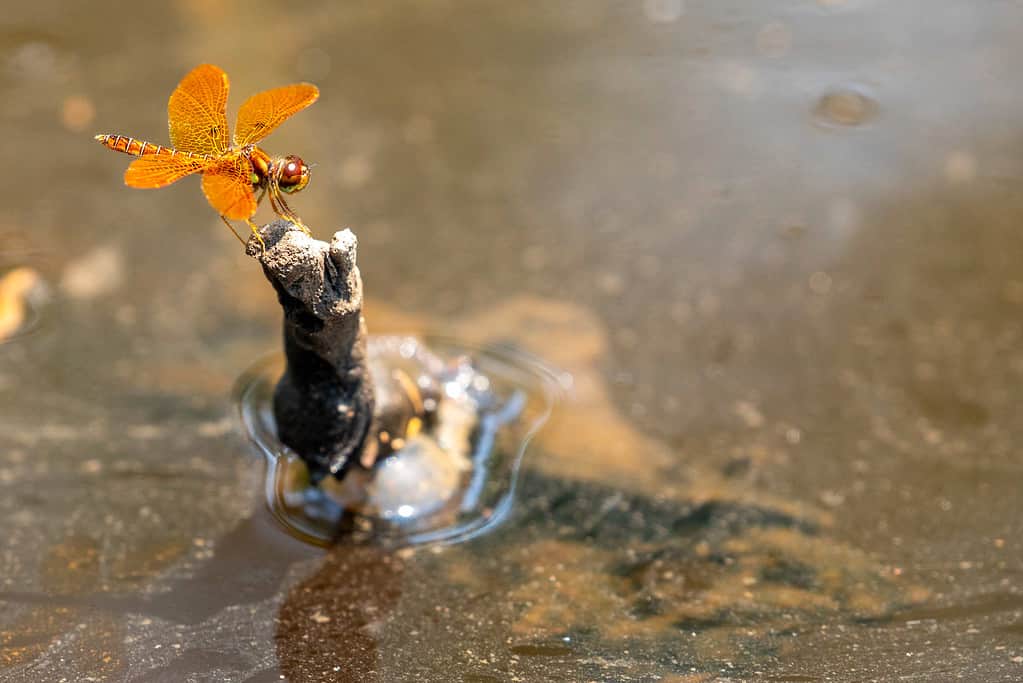
Adult dragonflies live near freshwater streams, canals, lakes, riverbanks, ditches, and ponds.
©Art Sublimina Photography/iStock via Getty Images
The life cycle of a dragonfly usually begins in mid to late summer. So where do dragonflies go in the winter? This animal does one of three things during the colder months: hibernates, migrates, or overwinters.
It all depends on what stage of the life cycle the dragonfly is in, the species, and where in the world they live. So let’s zoom out to examine the different evolutionary purposes of each habit.
Dragonfly Hibernation
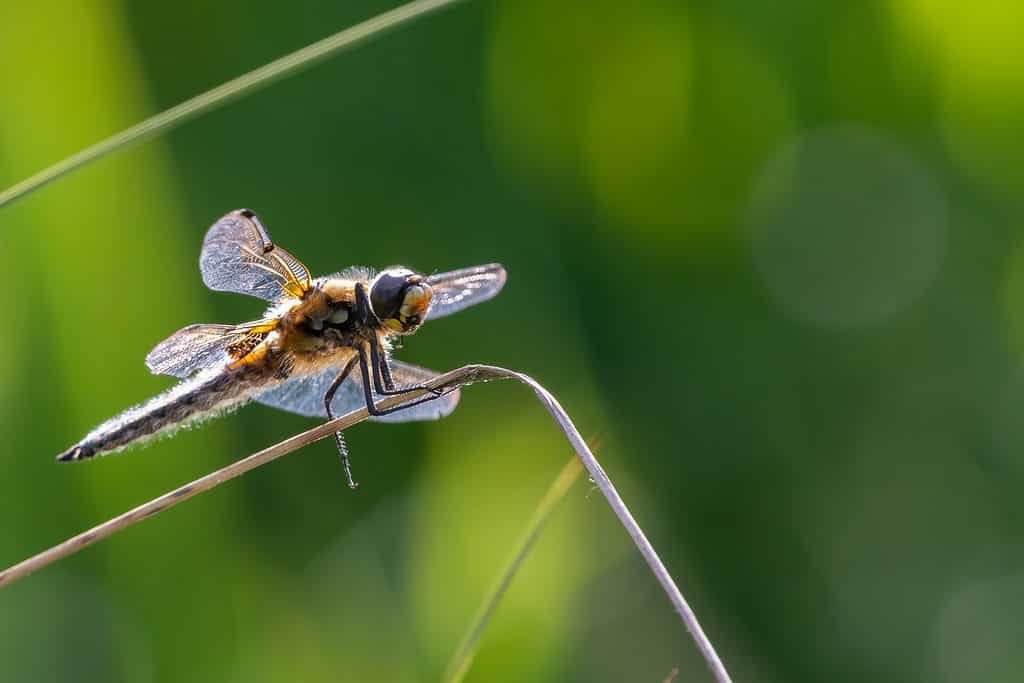
The four-spotted skimmer dragonfly migrates as an adult, but its larvae hibernate in a process called diapause.
©Alex Cooper Photography/Shutterstock.com
Hibernation is a seasonal activity characterized by low body temperature, slow breathing, decreased heart rate, and low metabolic rate. While adult dragonflies do not hibernate in the winter, dragonflies in the egg or larva stage do! In a process similar to hibernation — called diapause — the developing dragonfly’s metabolism slows down and the insect enters into a state of suspended animation.
Where do Dragonflies Hibernate in the Winter and Why?
Eggs or larvae can be found hibernating in leaf litter, tree bark, underground and underwater burrows, mud, or submerged vegetation during the winter. This protects the vulnerable insects from hungry predators that can easily snatch them up as a quick snack.
Dragonfly Migration
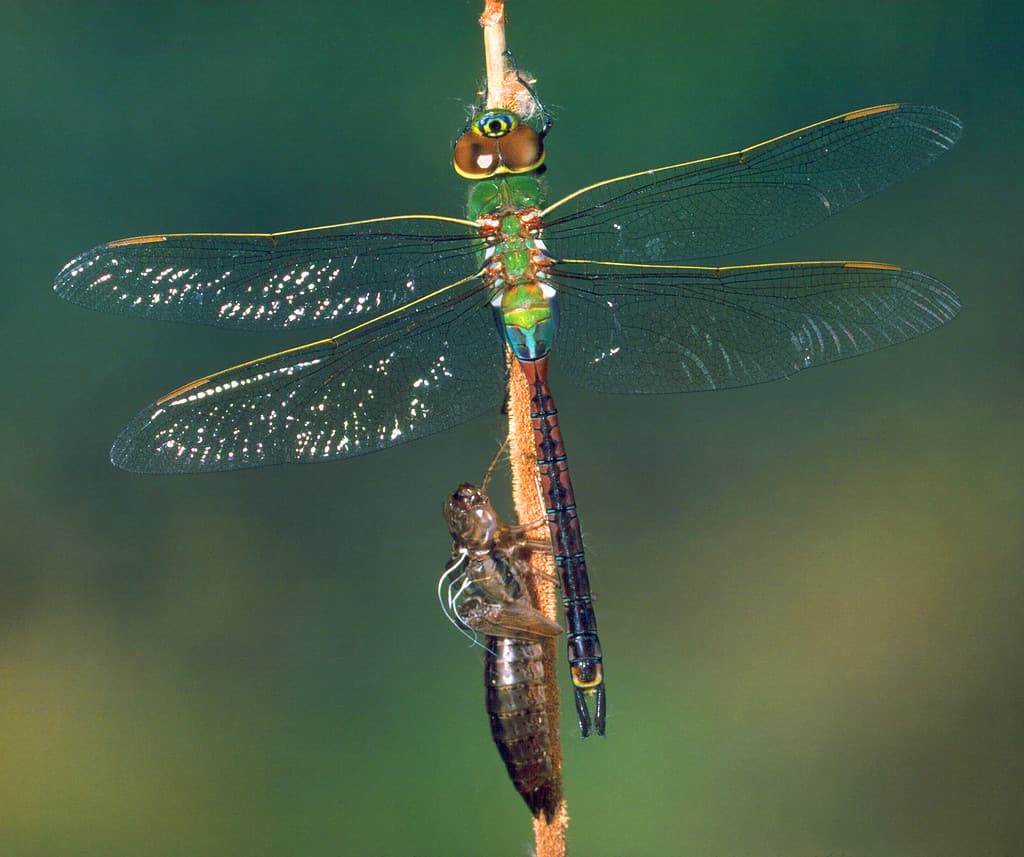
The green darner molts for the final time, preparing for migration south.
©AndrewASkolnick/Shutterstock.com
Migration is the movement of a group from one place to another. For the dragonfly, this means flying from the north to the south in the winter to escape the cold! However, only adult dragonflies migrate. That’s because their eggs and larvae can’t breathe air or fly yet. But wow, do some adult species of this insect move!
When Do Dragonflies Migrate?
The species most likely to migrate is called the green darner. Interestingly, this insect moves south individually instead of as a group.
Adult dragonflies travel close to 11,000 miles during their migration. The migration of certain species of dragonflies in the Northern Hemisphere begins in August when they fly south. They return when the weather turns, usually between March and June.
It’s notoriously hard to study dragonfly migration patterns because they are too small to wear trackers and are lightning-fast — they can fly up to 35 miles per hour! However, scientists got creative over the years and have been able to learn a lot about this incredible insect.
Dragonfly Overwintering
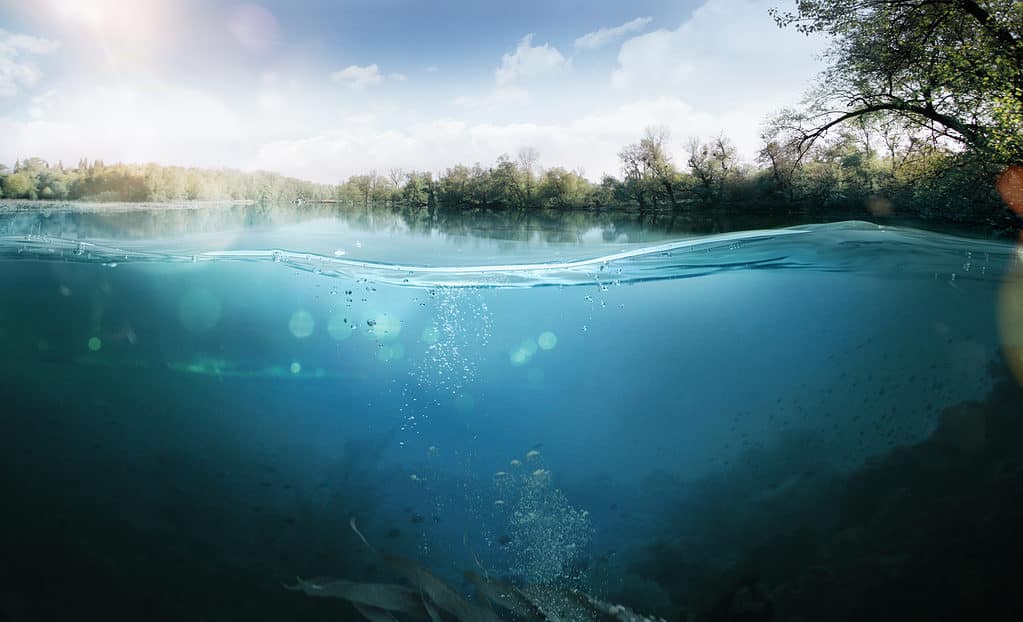
When flying away isn’t an option, dragonfly eggs and larvae settle into their underwater homes for the winter months.
©Rocksweeper/Shutterstock.com
Overwintering is passing through the season without leaving the area or hibernating. Dragonflies can do this as eggs or larvae. They can’t migrate to escape the cold, winter months so where do they go? They find pockets of warmth where they are!
How do Dragonflies Survive in the Winter?
Dragonflies can survive the cold without migrating because they live underwater. This is possible in the winter because water temperatures take longer to lose the warmth of the summer sun, which keeps it warmer for longer. Additionally, if the water is deep enough, ice forming on the surface can insulate the water below. Dragonflies are adapted to survive in their environment as they grow and develop. Overwintering is one way they do that!
Dragonfly Predators
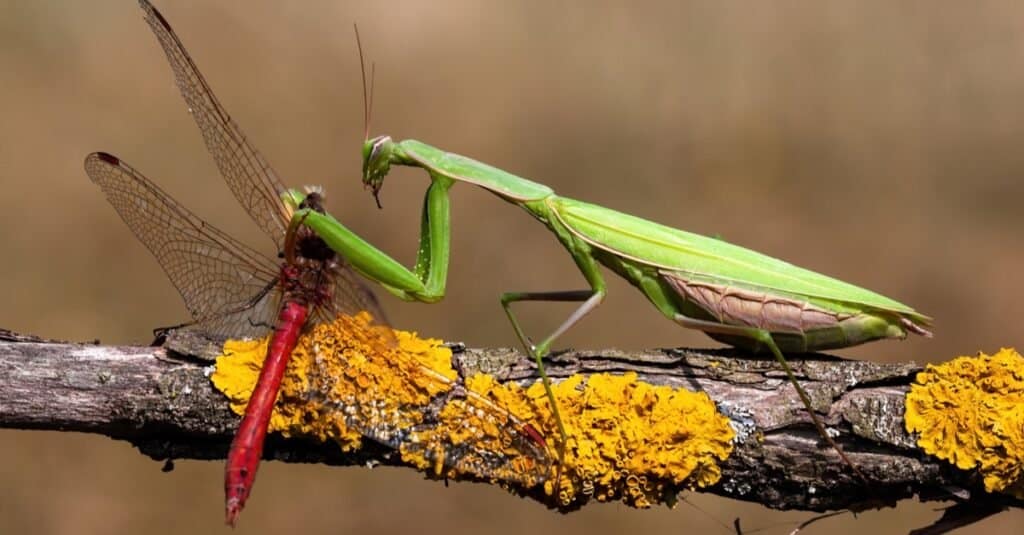
The green European mantis is one of many predators of the dragonfly.
©WildMedia/Shutterstock.com
While the dragonfly is a ferocious predator itself, it is not at the top of the food chain. Eggs and nymphs are most delicious to:
While adult dragonflies are typically food for:
Do Dragonflies Return to the Same Place Every Year?
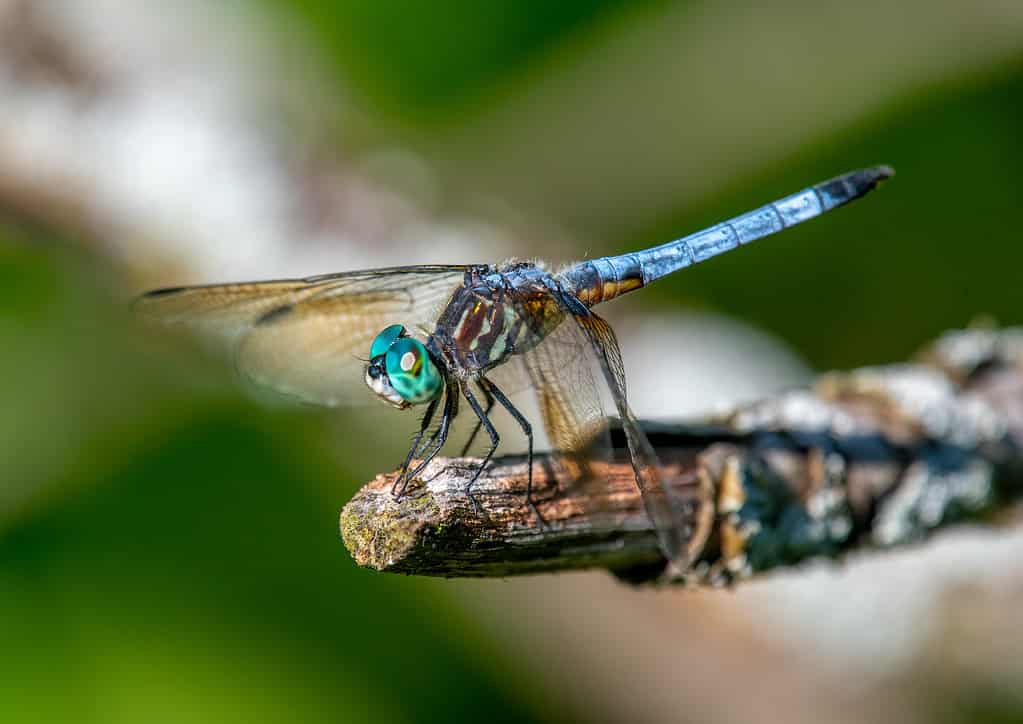
Dragonflies only live for a few months after entering adulthood, so it takes at least two generations to complete the migration process.
©Gerald DeBoer/iStock via Getty Images
After a harsh winter, it’s time for the dragonflies that migrated south for the season to make their way up north again. However, there is no evidence that dragonflies return to the same location every year. That’s likely because the generation that migrates south in the winter is not the same generation that flies north in the spring.
Dragonflies only live for a few months after entering adulthood, so it takes at least two generations to complete the migration process. The offspring of the individual dragonflies that flew south for the winter are the ones that complete the journey.
Now that you know more about the dragonfly, such as what their life cycle is like and where they go in the winter, don’t stop learning about this incredible insect!
The photo featured at the top of this post is © Charles J. Sharp / CC BY-SA 4.0 – License / Original
Thank you for reading! Have some feedback for us? Contact the AZ Animals editorial team.




